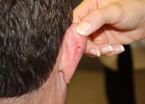(Press-News.org) PROVIDENCE, R.I. [Brown University] — In the powerful sunlight of July, newly published results from a large study of people at high risk for basal cell carcinoma support the emerging view of the nation's most common cancer as a chronic ailment that often repeatedly afflicts older people but for which the seeds may be planted in youth. The research also found a new association with eczema.
"Basal cell carcinoma is a chronic disease once people have had multiple instances of it, because they are always at risk of getting more," said Dr. Martin Weinstock, professor of dermatology in the Warren Alpert Medical School of Brown University, who practices at the Providence Veterans Affairs Medical Center. "It's not something at the moment we can cure. It's something that we need to monitor continually so that when these cancers crop up we can minimize the damage."
Dermatologists hold out hope for a medication that will help prevent recurrences of BCC. To test one such medicine, Weinstock chaired the six-site, six-year VA Topical Tretinoin Chemoprevential Trial, which last year found that the skin medication failed to prevent further instances of BCC in high-risk patients.
Weinstock is the corresponding author of the new study, published online July 19 in the Journal of Investigative Dermatology, which presents an analysis of the risk predictors of BCC recurrence found among the trial's population of 1,131 people, all of whom were veterans, 97 percent of whom were men, and whose median age was 72. On average, a participant had more than three episodes of BCC or squamous cell carcinoma before entering the study.
History, eczema, and early exposure
Overall, 44 percent of study participants developed new BCCs during the study period. The biggest predictor of another bout with BCC after three to four years of follow-up was a prior history of them. The 129 participants who had more than five BCCs in the five years before the study had a hazard rate ratio that was nearly four times as high as that of the 204 people who had none or one and more than twice as high that of the 200 people who had three.
Eczema was another predictor of BCC recurrence in the study's high-risk group. Participants who acknowledged a family history of the skin condition had a hazard rate ratio 1.54 times higher than people who did not, after statistical adjustments.
"We don't know why this is," Weinstock said. "The connection with eczema is something that's new, that needs to be further explored."
Age was another predictor, and not just in providing further confirmation that the risk people face increases with age. The study also showed that particularly intense sun exposure before the age of 30 was a strong a predictor of BCC occurrence among the high-risk study population, even though for most of them their 30s were decades ago.
"We talk about sun protection, which is important, but that's something for basal cell that's most important in your youth," Weinstock said. "While we don't exonerate UV exposure in one's 40s, 50s, and 60s, it was particularly UV exposure before the age of 30 that was most closely related to BCC in our study."
Awaiting a new trial
If limiting UV exposure is most crucial before the age of 30, what can doctors do for older people who may be headed for multiple bouts with BCC?
"Right now we have this wait and cut approach," he said. "We know these people are at high risk and we know that most of them are going to get more."
A better solution comes back to finding and testing preventive medication. Tretinoin didn't work, but Weinstock said he and his colleagues are testing another called 5-Fluorouracil. He said he is optimistic but has not yet seen the data from a trial that began about three years ago.
INFORMATION:
Robert Dyer of the Providence VA Medical Center and Brown University was the study's lead author. In addition to Dyer and Weinstock, other authors on the paper are Tobias Cohen, Amilcar Rizzo, Stephen Brigham and the VATTC Trial Group.
The U.S. Department of Veterans Affairs Co-operative Studies Program funded the research.
Basal cell carcinoma risk can be chronic
Study assessed predictors for more than 1,000 high-risk participants
2012-07-26
ELSE PRESS RELEASES FROM THIS DATE:
High blood sugar, obesity increase risk for surgical site infection
2012-07-26
Two recent studies in the July issues of the Journal of Bone and Joint Surgery (JBJS) looked at surgical site infections and hyperglycemia, the technical term for high blood glucose, or high blood sugar. According to the first study "Relationship of Hyperglycemia and Surgical-Site Infection in Orthopaedic Surgery," high blood sugar is a concern during the post-traumatic and post-operative period and it may help to preoperatively identify a population of patients with musculoskeletal injuries who are at significant risk for infectious complications.
Nearly, one-third ...
Sum of the parts? How our brains see men as people and women as body parts
2012-07-26
When casting our eyes upon an object, our brains either perceive it in its entirety or as a collection of its parts. Consider, for instance, photo mosaics consisting of hundreds of tiny pictures that when arranged a certain way form a larger overall image: In fact, it takes two separate mental functions to see the mosaic from both perspectives.
A new study suggests that these two distinct cognitive processes also are in play with our basic physical perceptions of men and women -- and, importantly, provides clues as to why women are often the targets of sexual objectification.
The ...
Alpine Fault study shows new evidence for regular magnitude 8 earthquakes
2012-07-26
RENO, Nev. – A new study published in the prestigious journal Science, co-authored by University of Nevada, Reno's Glenn Biasi and colleagues at GNS Science in New Zealand, finds that very large earthquakes have been occurring relatively regularly on the Alpine Fault along the southwest coastline of New Zealand for at least 8,000 years.
The Alpine Fault is the most hazardous fault on the South Island of New Zealand, and about 80 miles northwest of the South Island's main city of Christchurch.
The team developed evidence for 22 earthquakes at the Hokuri Creek site, ...
ACR: Medical imaging study in health affairs incomplete and potentially misleading
2012-07-26
In response to a study published in the August issue of Health Affairs regarding declining medical imaging use in recent years, the American College of Radiology (ACR) released a statement explaining that physician education efforts and quality assurance steps have resulted in more efficient use of imaging, but that arbitrary Medicare cuts are damaging patient access to care. The ACR also cited a December 2011 Health Affairs article that shows Medicare imaging cuts may have resulted in physical harm to patients.
"This Health Affairs study further supports the fact that ...
Disabled Pakistani women abandoned, ignored after quake
2012-07-26
(Edmonton) Women who suffered spinal injuries in the 2005 Pakistan earthquake continued to endure hardships years later, including abandonment by spouses and families, according to new research from the University of Alberta.
Zubia Mumtaz, an assistant professor in the School of Public Health who studies how gender and class inequalities affect maternal health, worked with a team of graduate students to document the experiences of paraplegic women three years after the 7.6-magnitude quake that devastated Kashmir. They found that women—far more than men with similar spinal ...
NIH scientists identify likely predictors of hepatitis C severity
2012-07-26
Scientists at the National Institutes of Health have identified several factors in people infected with the hepatitis C virus that may predict whether the unusually rapid progression of disease from initial infection to severe liver conditions, such as cirrhosis, will occur. Knowing whether a patient's condition is likely to deteriorate quickly could help physicians decide on the best course of treatment.
The study was conducted by an international team of researchers led by Patrizia Farci, M.D., chief of the Hepatic Pathogenesis Section in the Laboratory of Infectious ...
NIH-funded study finds high HIV infection rates among gay and bisexual black men in the US
2012-07-26
WHAT:
The rate of new HIV infections among black men who have sex with men (MSM) in the United States, particularly younger men, is high and suggests the need for prevention programs specifically tailored to this population, according to initial findings from the HPTN 061 study. The preliminary results were presented at the XIX International AIDS Conference (AIDS 2012) in Washington, D.C., by study co-chair Kenneth Mayer, M.D., medical research director for the Fenway Community Health Center in Boston.
The HPTN 061 study, which involved 1,553 black MSM ages 18 and older ...
Controlling monkey brains and behavior with light
2012-07-26
Researchers reporting online on July 26 in Current Biology, a Cell Press publication, have for the first time shown that they can control the behavior of monkeys by using pulses of blue light to very specifically activate particular brain cells. The findings represent a key advance for optogenetics, a state-of-the-art method for making causal connections between brain activity and behavior. Based on the discovery, the researchers say that similar light-based mind control could likely also be made to work in humans for therapeutic ends.
"We are the first to show that optogenetics ...
Writing in cursive with your eyes only
2012-07-26
VIDEO:
A new technology described in the paper published online on July 26 in Current Biology, a Cell Press publication, might allow people who have almost completely lost the ability to...
Click here for more information.
A new technology described in the paper published online on July 26 in Current Biology, a Cell Press publication, might allow people who have almost completely lost the ability to move their arms or legs to communicate freely, by using their eyes to ...
Whole-genome sequencing of African hunter-gatherers reveals human genetic diversity
2012-07-26
Genome sequences of African hunter-gatherers from three different populations reveal insights into how humans have adapted to distinct environments over evolutionary history. By sequencing whole genomes of individuals within these groups, a team of scientists has substantially expanded knowledge about the scope of genetic diversity in humans, publishing their findings on July 26th in the journal Cell.
Africa is the ancestral homeland of all modern humans and contains the highest level of genetic diversity among all of the continents. "Even though African populations ...
LAST 30 PRESS RELEASES:
There are new antivirals being tested for herpesviruses. Scientists now know how they work
CDI scientist, colleagues author review of global burden of fungus Candida auris
How does stroke influence speech comprehension?
B cells transiently unlock their plasticity, risking lymphoma development
Advanced AI dodel predicts spoken language outcomes in deaf children after cochlear implants
Multimodal imaging-based cerebral blood flow prediction model development in simulated microgravity
Accelerated streaming subgraph matching framework is faster, more robust, and scalable
Gestational diabetes rose every year in the US since 2016
OHSU researchers find breast cancer drug boosts leukemia treatment
Fear and medical misinformation regarding risk of progression or recurrence among patients with breast cancer
Glucagonlike peptide-1 receptor agonists and asthma risk in adolescents with obesity
Reviving dormant immunity: Millimeter waves reprogram the immunosuppressive microenvironment to potentiate immunotherapy without obvious side effects
Safety decision-making for autonomous vehicles integrating passenger physiological states by fNIRS
Fires could emit more air pollution than previously estimated
A new way to map how cells choose their fate
Numbers in our sights affect how we perceive space
SIMJ announces global collaborative book project in commemoration of its 75th anniversary
Air pollution exposure and birth weight
Obstructive sleep apnea risk and mental health conditions among older adults
How talking slows eye movements behind the wheel
The Ceramic Society of Japan’s Oxoate Ceramics Research Association launches new international book project
Heart-brain connection: international study reveals the role of the vagus nerve in keeping the heart young
Researchers identify Rb1 as a predictive biomarker for a new therapeutic strategy in some breast cancers
Survey reveals ethical gaps slowing AI adoption in pediatric surgery
Stimulant ADHD medications work differently than thought
AI overestimates how smart people are, according to HSE economists
HSE researchers create genome-wide map of quadruplexes
Scientists boost cell "powerhouses" to burn more calories
Automatic label checking: The missing step in making reliable medical AI
Low daily alcohol intake linked to 50% heightened mouth cancer risk in India
[Press-News.org] Basal cell carcinoma risk can be chronicStudy assessed predictors for more than 1,000 high-risk participants




